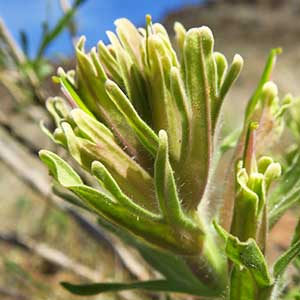Castilleja xanthotricha
Castilleja nivea
John Day or yellow-hairy paintbrush, John Day paintbrush, yellow hair paintbrush, yellow-hair Indian paintbrush
snow Indian paintbrush, snow paintbrush, snowy paintbrush
few to several, ± decumbent to erect or ascending, unbranched, sometimes with short, leafy axillary shoots, hairs erect to spreading, long, soft, eglandular, mixed with short stipitate-glandular ones.
few to several, erect to ascending, decumbent at base, unbranched except for small, leafy axillary shoots, hairs weakly spreading to appressed, ± matted, especially distally on stem, fairly short and sparse proximally, longer and denser distally, soft, eglandular, becoming woolly, often obscuring surface.
green, linear, lanceolate to broadly lanceolate, oblong, or cuneate, 0.8–5 cm, not fleshy, margins plane to wavy, involute, 0–5-lobed, apex acute, sometimes rounded;
lobes spreading, linear, arising below mid length, nearly as broad as center lobe, apex acute.
gray with hairs, surface green to purple, linear to narrowly lanceolate, 1–3.8 cm, not fleshy, margins plane, sometimes ± wavy, involute, 0–3-lobed, apex acute;
lobes ascending-spreading, linear to narrowly lanceolate, apex acute to obtuse.
3–14 × 1.5–4.5 cm;
bracts proximally greenish, rarely dull reddish purple, distally white to cream, rarely pale yellow or dull, pale pink (sharply differentiated from proximal coloration), lanceolate or oblong to narrowly ovate, (3–)5–7-lobed;
lobes ascending, linear to obovate, ± broadened distally, medium, long, proximal lobes arising below mid length, central lobe apex broadly rounded to truncate, others acute to rounded.
2.5–6 × 1–2.5 cm;
bracts greenish to pale yellow-green or very pale, dull purplish throughout, lanceolate to oblong, (0–)3(–5)-lobed;
lobes usually ascending, linear, medium length to long, arising near mid length, apex acute.
curved, 17–23 mm;
tube 15–19 mm;
beak exserted, adaxially green, 5–8(–9) mm, puberulent, stipitate-glandular;
abaxial lip deep purple (color sometimes visible through calyx), green, pinkish, or pale yellow, ± prominent, slightly inflated, usually hidden in calyx, sometimes right at top of calyx, 2 mm, ca. 50% as long as beak;
teeth ascending, whitish, yellowish, pink, or green, 1–1.5 mm.
straight, 18–25 mm;
tube 3.5–5.5 mm; subequal to calyx, or beak and sometimes abaxial lip exserted;
beak adaxially yellow, 6–8 mm, hairs moderately long, matted on midline, very short-glandular on sides;
abaxial lip green, inconspicuous, slightly pouched, 3.5–5.5 mm, 60–90% as long as beak;
teeth erect, white or yellow, 0.5–3 mm.
colored as bracts, 15–26 mm;
abaxial and adaxial clefts 3.5–7 mm, 25–50% of calyx length, deeper than laterals, lateral 2–5 mm, 12–25% of calyx length;
lobes linear, oblong, or narrowly triangular, center lobe apex usually rounded, lobes acute to rounded.
yellow, color mostly obscured by whitish hairs, 15–22 mm;
abaxial, adaxial, and lateral clefts (5.5–)7–12 mm, 35–55% of calyx length, often appearing shorter because matted hairs stitch proximal part of clefts shut, all 4 clefts subequal;
lobes broadly linear, apex acute.
= 48.
= 24.
Castilleja xanthotricha
Castilleja nivea
Castilleja xanthotricha is endemic to moderate elevations in the sagebrush hills of the John Day River drainage in north-central Oregon. N. H. Holmgren (1971) hypothesized that this tetraploid species is of allopolyploid hybrid origin between C. glandulifera and C. oresbia.
(Discussion copyrighted by Flora of North America; reprinted with permission.)
Castilleja nivea is endemic to alpine habitats in the mountains of northwestern Wyoming and adjacent Montana. It forms occasional hybrids with C. pulchella, which often shares its habitat, as on the Beartooth Plateau in northwestern Wyoming.
(Discussion copyrighted by Flora of North America; reprinted with permission.)
